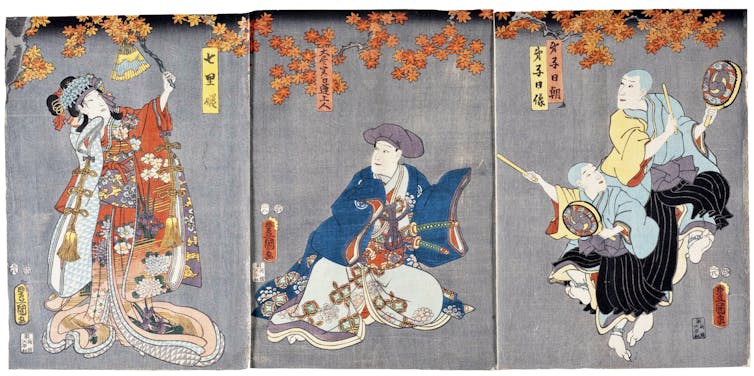
When Tina Turner, often dubbed the “Queen of Rock ‘N’ Roll,” died at her home in Küsnacht, Switzerland, on May 24, 2023, at the age of 83, media headlines praised both her dynamism as a performer and her many career achievements. What many did not know is that for the past 50 years Turner had practiced Soka Gakkai International Nichiren Buddhism.
Soka Gakkai is a lay Nichiren Buddhist organization that was founded in Japan in 1930. Today, the international organization is known as Soka Gakkai International, or SGI. This form of Buddhism was popularized in the United States through the organization known today as SGI-USA. Turner was introduced to the organization by Valerie Bishop, a woman whom her first husband, musician Ike Turner hired to work in his recording studio.
Turner’s Buddhist practice developed initially against the backdrop of her first marriage and continued throughout her solo career. It provided inspiration for some of the final projects of her career.
As a scholar of Buddhism in South Asia and in the U.S., I have closely studied the career of African American artists who practice Buddhism. Tina Turner, in particular, sought to teach Buddhism through her writings and later through her records.
Turner’s early religious life
Turner was born on Nov. 26, 1939, and raised in the community of Nutbush, Tennessee. Her family was Baptist and worshipped at both Woodlawn Missionary Baptist Church and Spring Hill Baptist Church. They also sometimes attended a Black Pentecostal church near Knoxville, Tennessee.
As I found while doing research for my forthcoming book, “Dancing in My Dreams: A Spiritual Biography of Tina Turner,” Turner’s religious influences extended beyond the forms of Afro-Protestant institutional religion. In her memoir “Happiness Becomes You,” Turner describes the deep, mystical connection that her grandmother had to nature, which suggests that her grandmother was immersed in the more mystical strands of Black Southern religious culture.
In 1957, she met Ike Turner. After she initially joined his band as vocalist, they eventually formed a musical partnership under the moniker The Ike & Tina Turner Revue.

The duo scored chart success with songs like “A Fool in Love,” “River Deep – Mountain High,” “Proud Mary” and “Nutbush City Limits.” Though publicly successful, in private Ike frequently abused Tina Turner.
Introduction to Buddhism
Turner was introduced to the teachings of Nichiren Buddhism in 1973. Nichiren Buddhism is based on the teachings of Nichiren, a Buddhist monk who lived during the 13th century in Japan. Central to Nichiren’s thought was the conviction that the Lotus Sūtra, a Mahayana Buddhist text, was the highest of all the Buddha’s teachings.

Nichiren taught that chanting the title of this scripture in the form of the mantralike phrase “Nam-myoho-renge-kyo” was the way for all people to reveal their inherent potential for awakening and attain buddhahood. Further, Nichiren taught that doing this practice would have profound social impact by making the Buddha’s highest teachings the basis of society.
How Nichiren Buddhism was popularized
Soka Gakkai members began arriving in the U.S. in the 1950s. As these members spoke primarily Japanese and were geographically spread out, they initially had limited success in their efforts to propagate Nichiren Buddhism in the U.S. That changed in 1960 when, under the leadership of the third Soka Gakkai president, Daisaku Ikeda, an American branch of the organization was formally established.
With his guidance, they spread the basic Nichiren Buddhist practice of chanting Nam-myoho-renge-kyo before an inscribed scroll called the Gohonzon. They taught that doing this practice would lead to “human revolution,” a gradual process of inner transformation and empowerment.
It is the SGI Nichiren Buddhist understanding of personal empowerment and human revolution that seems to have initially attracted Tina Turner. In a 2020 Tricycle Magazine interview, Turner explained: “As I began studying Buddhist teachings and chanting more, it led me to take responsibility for my life and to base my choices on wisdom, courage, and compassion. Not long after I started chanting, I began to see that the power I needed to change my life was already within me.”
In the ‘70s, changing her life meant separating from the Ike & Tina Turner Revue in 1976 and divorcing Ike Turner in 1978.
A resurgence powered by SGI Nichiren Buddhism
After her divorce, Turner struggled as a solo artist before her well-known career resurgence with 1984’s “Private Dancer” album. Platinum albums and sold-out global tours followed. Turner credited each success to her Buddhist practice.
Her practice would be chronicled in two autobiographies: the first, “I, Tina,” published in 1986; and a second, “My Love Story,” published in 2018. Her practice is also represented in the 1993 biographical film “What’s Love Got to Do with It?” and on record on the 2009 interfaith album “Beyond: Buddhist and Christian Prayers” and on stage in the musical “Tina: The Tina Turner Musical.”
Through all of these projects, Turner made clear that her practice of SGI Nichiren Buddhism sustained her for the past 50 years.
Ralph H. Craig III receives funding from Stanford University. He is affiliated with SGI-USA, but he does not represent them in any capacity.
from The Conversation – Articles (US) https://ift.tt/hyVsOXb
 Reviewed by Admin
on
May 26, 2023
Rating:
Reviewed by Admin
on
May 26, 2023
Rating:




No comments: